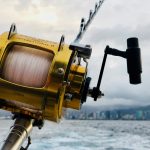What Is The Best Line Pound Test To Use When Saltwater Fishing?
Line pound test refers to the amount of pounds of pressure and fish exerts on the line before it breaks. Higher pound test lines mean it is a stronger line. A 20 to 25 line pound test is probably the best to use at this line can catch almost anything. Larger fish like tuna, marlin or shark will need at least a 30 line pound test. If you are just after small fish, 8 to 20 pound test is sufficient.
Saltwater fishing can be a thrilling experience for both novice and experienced anglers. However, one of the most common questions that arise when it comes to saltwater fishing is “what is the best line pound test to use?” The answer to this question is not straightforward, as it depends on a variety of factors, including the type of fish you are targeting, the type of water you are fishing in, and the type of bait or lures you are using. In this article, we will explore the factors that influence the best line pound test to use when saltwater fishing.
The first factor to consider is the type of fish you are targeting. Different species of fish have different strengths, and some require a higher line pound test than others. For example, if you are targeting small or medium-sized fish like snapper or trout, you may only need a line pound test of 10 to 20 pounds. However, if you are targeting larger game fish like marlin or tuna, you may need a line pound test of 50 to 80 pounds or even more.
Another important factor to consider is the type of water you are fishing in. The strength of the current and the depth of the water can affect the amount of line you need. For example, if you are fishing in deep waters with strong currents, you may need a higher line pound test to ensure that the line can withstand the pressure of the water and the weight of the fish. In contrast, if you are fishing in shallow waters with weaker currents, you may be able to use a lower line pound test.
The type of bait or lure you are using can also influence the best line pound test to use. Different types of bait or lures require different types of lines, and some may require a higher line pound test than others. For example, if you are using live bait or soft plastics, you may need a lower line pound test to ensure that the bait or lure moves naturally in the water. On the other hand, if you are using heavy metal jigs or spoons, you may need a higher line pound test to ensure that the line can withstand the weight of the lure and the pressure of the water.
When it comes to saltwater fishing, it is also important to consider the type of line you are using. There are three main types of lines: monofilament, braided, and fluorocarbon. Monofilament lines are the most common type of line used in saltwater fishing and are suitable for most types of fishing. They are flexible and easy to handle, and they have good knot strength. Braided lines are more durable than monofilament lines and have higher sensitivity, making them ideal for deep-sea fishing. Fluorocarbon lines are nearly invisible in the water, making them ideal for fishing in clear water.
Now that we have covered the factors that influence the best line pound test to use when saltwater fishing, let’s look at some specific examples.
If you are targeting small or medium-sized fish like snapper, grouper, or trout in shallow waters, you may only need a line pound test of 10 to 20 pounds. For these types of fish, monofilament lines are ideal as they are flexible and easy to handle. However, if you are targeting larger fish like redfish or shark, you may need a line pound test of 30 to 50 pounds. Braided lines are ideal for these types of fish as they are more durable and have higher sensitivity.
If you are targeting game fish like marlin or tuna in deep waters, you may need a line pound test of 50 to 80 pounds or even more. Braided lines are ideal for these types of fish as they have higher sensitivity and are more durable than monofilament lines. However, fluorocarbon lines may also be a good choice as they are nearly invisible in the water and can help you trick the fish into biting.
When it comes to the type of bait or lure you are using, the best line pound test to use can vary widely. For example, if you are using live bait or soft plastics, you may need a lower line pound test to ensure that the bait or lure moves naturally in the water. A line pound test of 10 to 20 pounds may be sufficient for these types of baits. On the other hand, if you are using heavy metal jigs or spoons, you may need a higher line pound test to ensure that the line can withstand the weight of the lure and the pressure of the water. A line pound test of 30 to 50 pounds may be necessary for these types of lures.
When choosing the best line pound test to use for saltwater fishing, it is also important to consider the conditions of the water. For example, if you are fishing in clear water, you may want to use a fluorocarbon line as it is nearly invisible in the water and can help you trick the fish into biting. In contrast, if you are fishing in murky water, you may want to use a braided line as it has higher sensitivity and can help you detect bites more easily.
In conclusion, the best line pound test to use when saltwater fishing depends on a variety of factors, including the type of fish you are targeting, the type of water you are fishing in, and the type of bait or lure you are using. It is important to choose the right line pound test to ensure that your line can withstand the pressure of the water and the weight of the fish, while also providing the right level of sensitivity and flexibility. By considering these factors, you can choose the best line pound test for your saltwater fishing needs and increase your chances of success on the water.






